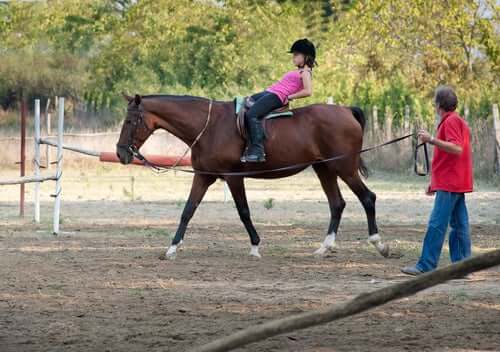All About the Benefits of Equine Therapy


Written and verified by the lawyer Francisco María García
Equine therapy, or equine-assisted therapy, consists of the use of horses in therapeutic activities for human beings. For many years, it was considered an alternative treatment and received considerable criticism. Fortunately, medical studies have advanced in recent decades. So, as a result, science has finally recognized the benefits of equine therapy for the health of human beings.
Currently, modern medicine and other disciplines highly recommend the activities that equine therapy and other animal-assisted therapies encompass. The indications are diverse, as well as the types of exercises and forms of contact with therapy horses.
A brief history of equine therapy
In recent decades, the number of doctors recommending horse-assisted therapy has grown significantly. Just the same, knowledge of the benefits of equine therapy is nothing new. In fact, civilizations from the classical period were already well aware of the benefits of equine therapy long ago.
The first known records of medical prescriptions of this type of treatment date back to Ancient Greece. At this time, people used horses in order to prevent and rehabilitate from a number of physical and psychological ailments.
During the 17th century, equine-assisted therapy regained importance in medical studies. From that point on, science has also recognized its benefits when it comes to treating the negative effects of gout.
The health benefits of equine therapy
The therapeutic principle that different equine therapy activities have in common is cognitive and motor stimulation.

At the same time, horses are sensitive, sociable, and perceptive animals. Contact with horses contributes to the development of communication, integration, and cognition skills in both children and adults. This is why the use of equine therapy is so common in the treatment of mental and neurological disorders and illnesses.
Medical indications of equine therapy
Consequently, equine therapy is gaining more and more territory in the treatment of a variety of physical and mental disorders. This is thanks to the multiple benefits that it offers in regards to the motor and neurological systems of chronic patients.
Currently, the use of horses as a therapeutic tool applies to the rehabilitation of children, adolescents, and adults. What’s more, it offers benefits on a psychological, neuromuscular, cognitive, and social level.
Examples of types of equine therapy
We can see the most common benefits of equine-assisted therapy in the treatment of the following illnesses and conditions:
- Brain injuries, strokes, and cerebral palsy
- Syndromes and injuries that affect the spinal cord
- Ataxias
- Asthma
- Parkinson’s disease
- Muscular dystrophy
- Syndromes that affect a person’s physical growth
- Disorders that affect a person’s ability to socialize with others
- Fibromyalgia
- Down Syndrome
- Autism
- Multiple Sclerosis
- Diverse motor difficulties and traumas
- Rehabilitation from accidents
- Physical and psychomotor disabilities
- Language and communication difficulties
- Behavior disorders
The different approaches to equine therapy
There are a number of different ways to carry out equine therapy. The best approach for each case has to do with the specific disorder, condition, or injury that requires treatment.
Therapeutic riding
You could say that therapeutic riding acts as the foundation for the different therapeutic activities involving horses. Therapeutic riding consists of carrying out controlled physical exercises while riding on a horse. Therefore, this approach to equine therapy is ideal for different types of psychoeducational and physiotherapeutic rehabilitation.
Hippotherapy
Hippotherapy consists of holistic treatment on a neurophysiological level that takes place on the back of a horse. The activities are carried out according to medical orientation under the supervision of physical therapists that specialize in equine therapy.
The foundation of this type of therapy is trifold:
- Firstly, the transmission of warmth to the patient through the horse’s own body temperature
- Secondly, the rhythmic impulses of these therapeutic animals
- And, lastly, the three-dimensional movements of horses
Psychoeducational horseback riding
Psychoeducational horseback riding is a compilation of pedagogical and psychological interventions. It’s especially useful when it comes to helping children who have learning difficulties or who have a hard time concentrating.
However, psychoeducational horseback riding is also used in improving the independence and adaptation of individuals with disabilities.

Social equine therapy
Social equine therapy shares the same basic activities as psychoeducation horseback riding. However, it focuses on the therapeutic relationship that develops between horses and patients.
It’s common for specialists to prescribe this type of equine therapy to improve the social insertion and communication of individuals with autism. Furthermore, social equine therapy is also a useful resource for rehabilitation from psychological trauma and behavior problems.
Adapted horseback riding
This type of equine therapy focuses on the adaptation of horseback riding as a sport for individuals with physical disabilities.
Occupational therapy with horses
In this approach to equine therapy, the horses serve as a means of improving the employability of individuals with disabilities.
Equine therapy in all of its variants should only take place under the orientation of specialized professionals. Each patient should receive personalized attention and treatment. This will determine the horse to be used, the planning of exercises, and the frequency of sessions.
Source of the main image: Photojournalism workshop
This text is provided for informational purposes only and does not replace consultation with a professional. If in doubt, consult your specialist.